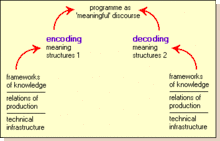Speaking Into The Air
Speaking into the Air: A History of the Idea of Communication, written by American scholar John Durham Peters, is a major work in communication studies and the author's first book. Peters asserts that communicating like angels is "impossible" but it is not just a tragic fact but also a blessed one. This book talks about the history of communication failure from different aspects like philosophy, politics, media technology and so forth. This book won the National Communication Association Award in 2000.
Themes
Speaking into the Air: A History of the Idea of Communication studies communication failure. It contains five phrases of history of the idea of Communication, Plato's eros, The Bible's one-way dissemination, religious angel communication in Middle Ages, spiritual communication in modern philosophy, and the communication idea in modern communication theory. It also involves the subject machines, animals and aliens as horizons of incommunicability.
Book review
At the end of the Introduction "The Problem of Communication", Peters asserts that "dissemination" can be more charming:
"The most beautiful thing about our contact with each other is its free dissemination, not its anguished communion. The ultimate futility of our attempts to "communicate" is not lamentable; it is a handsome condition. The notion of communication deserves to be liberated from its earnestness and spiritualism, its demand for precision and agreement, demands whose long history I attempt to illustrate in this book. The requirement of interpersonal mimesis can be despotic...The idea of communication, as Adorno said, would be a condition in which the only thing that survives the disgraceful fact of our mutual difference is the delight that the difference makes possible."
In the first chapter, "Dialogue and Dissemination," Peters compares two forms of communication: dialogue and dissemination and makes an argument that “dialogue can be tyrannical and dissemination can be just”, which provides an interesting perspective of one-way communication: dissemination. And my study about dissemination of Chinese literature is based on the pressing industries, is all about book. Compared to radio, television, internet, books like newspaper, magazines and other pressing productions can be more like the media of one-way communication, since we can easily make instant interactions through radio, television, internet but as for books, due to the lack of interaction, the audiences may have more time and freedom to interpret meanings by themselves.
To illustrate, we may use the theory of Encoding and Decoding by Stuart Hall, as shown right:

A programme can be encoded and decoded separately by different groups of people. In a dialogue or any other means of interaction, encoding and decoding can happen in turn or together frequently within a certain time between the two sides. And because of such strong interaction in it, say, the two sides have hugely different frameworks of knowledge, and then what will happen? Probably, they start to fight against each other... more emotion and non-rationality are filled in. Say, the two sides are more polite and open to the other’s opinions and maybe they have to force themselves to adjust their framework of knowledge and achieve a consistent but not perfectly accepted point at the end. As Peters said, dialogue can be tyrannical. More conflicts and disgraceful compromise may happen in a dialogue. Of course, in a one-way dissemination, say the dissemination of Chinese Contemporary literature books overseas, the process of encoding of Chinese writers is complete without too much distraction from the audiences overseas. The writers can fill their knowledge, feelings and thoughts in their books. And through the dissemination overseas, audiences in the far access the productions and decode the meanings by themselves with less distraction. Of course, the audiences could write book reviews or make direct connections to the authors, and at the same time, the authors could hold book launches or make a speech to make connections with the authors. But this kind of interaction afterwards can’t compete with the counterpart in instant dialogues in a phone call and chats in the social media, where encoding and decoding happen together at the same time. This kind of inspires me to reconsider the beauty of "dissemination"----one-way communication. But we should also realize that either in a dialogue or the dissemination, the failure always exists. Regardless of the tragedy, what we should also keep in mind is that “ the idea of communication, as Adorno said, would be a condition in which the only thing that survives the disgraceful fact of our mutual difference is the delight that the difference makes possible.”
See also
References
John Durham Peters, 1999. Speaking into the Air: A History of the Idea of Communication. Chicago: University of Chicago Press